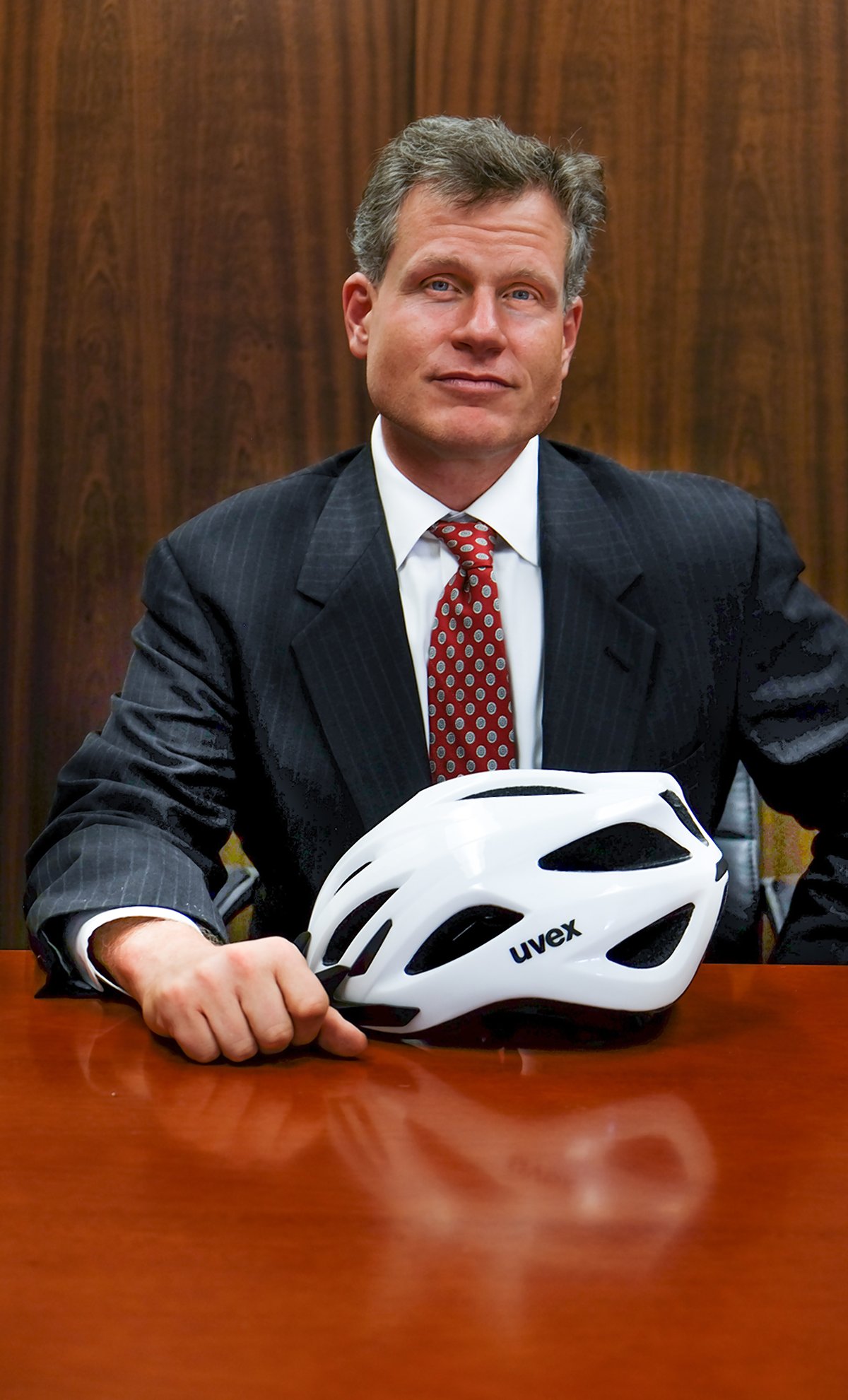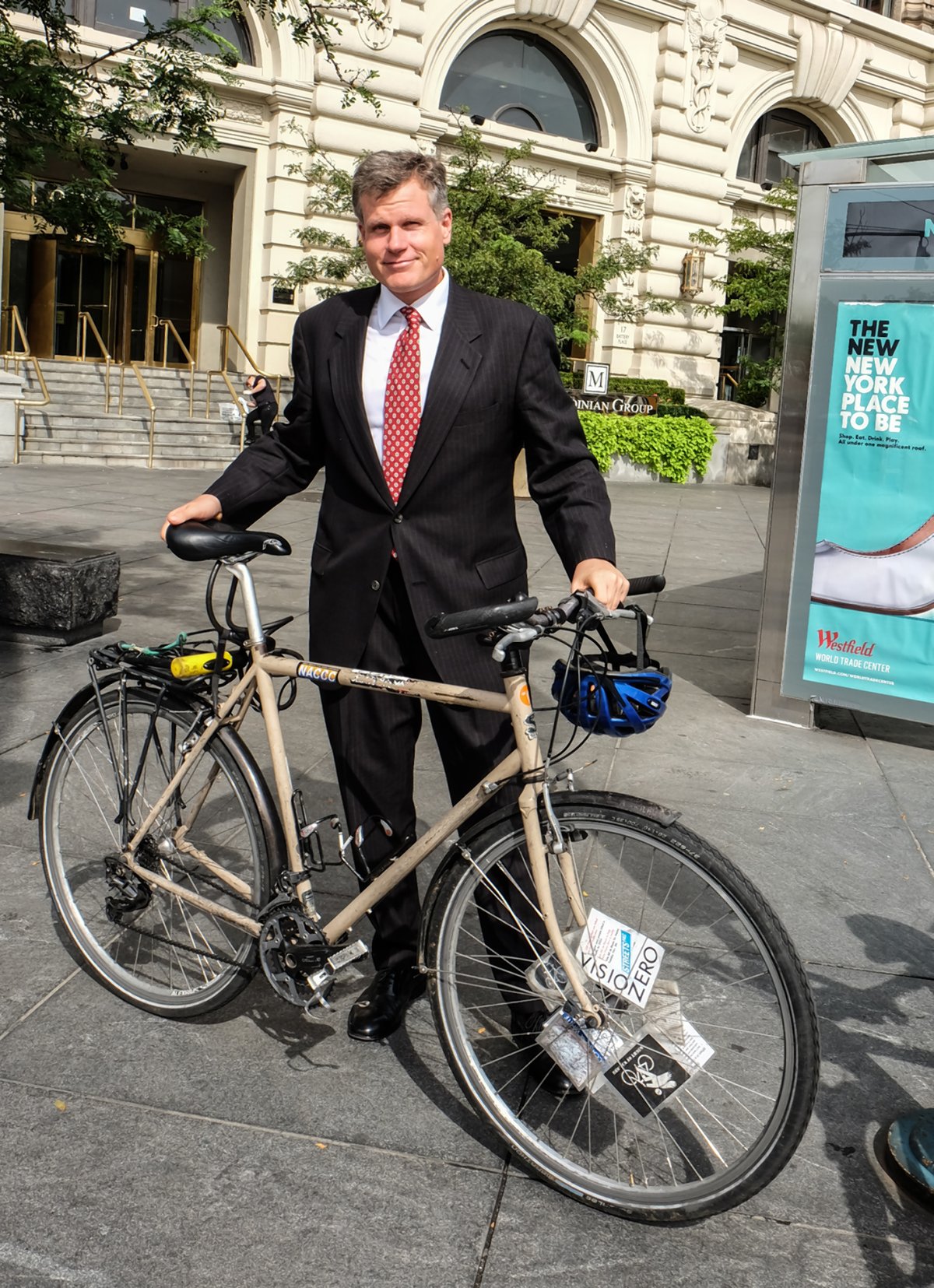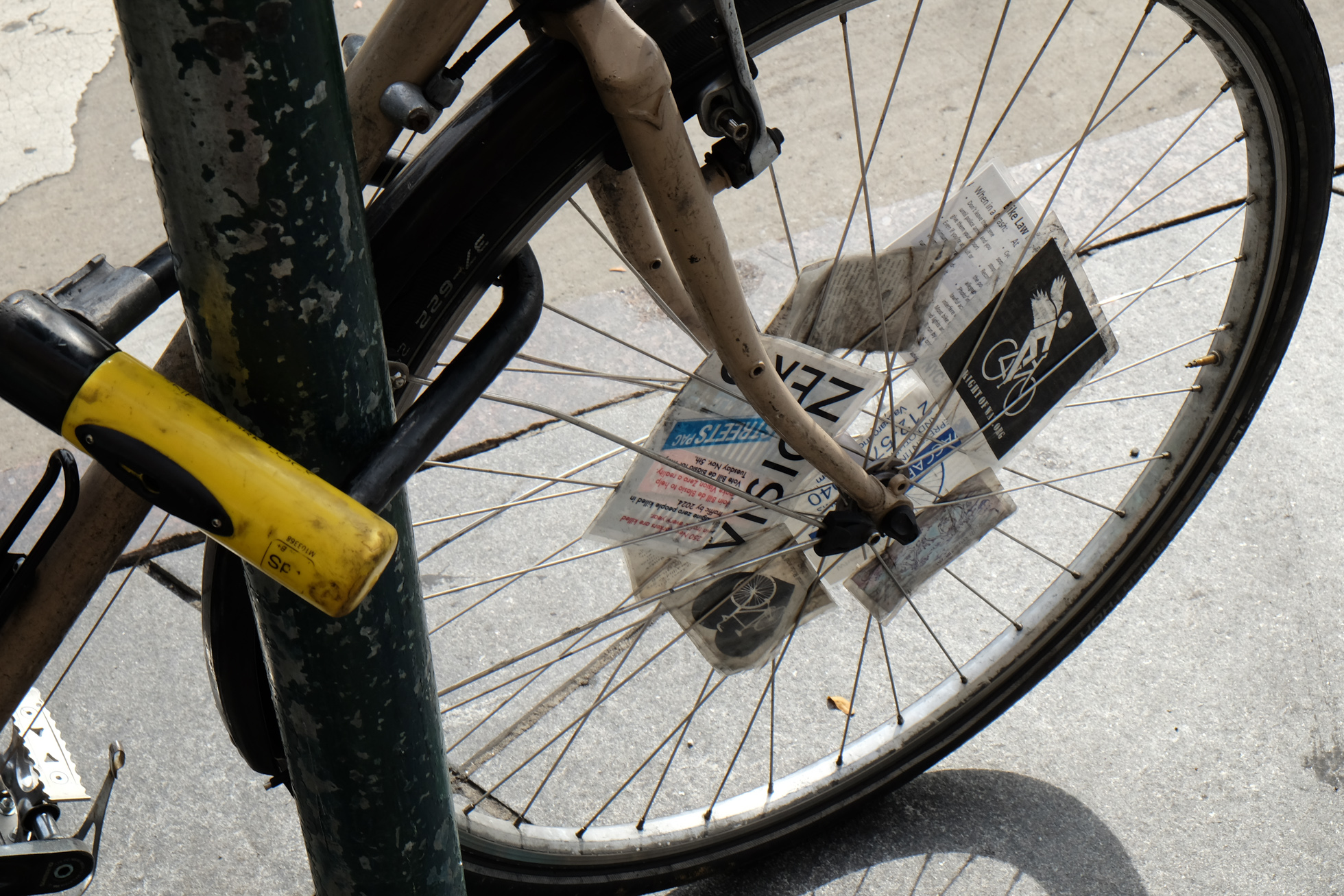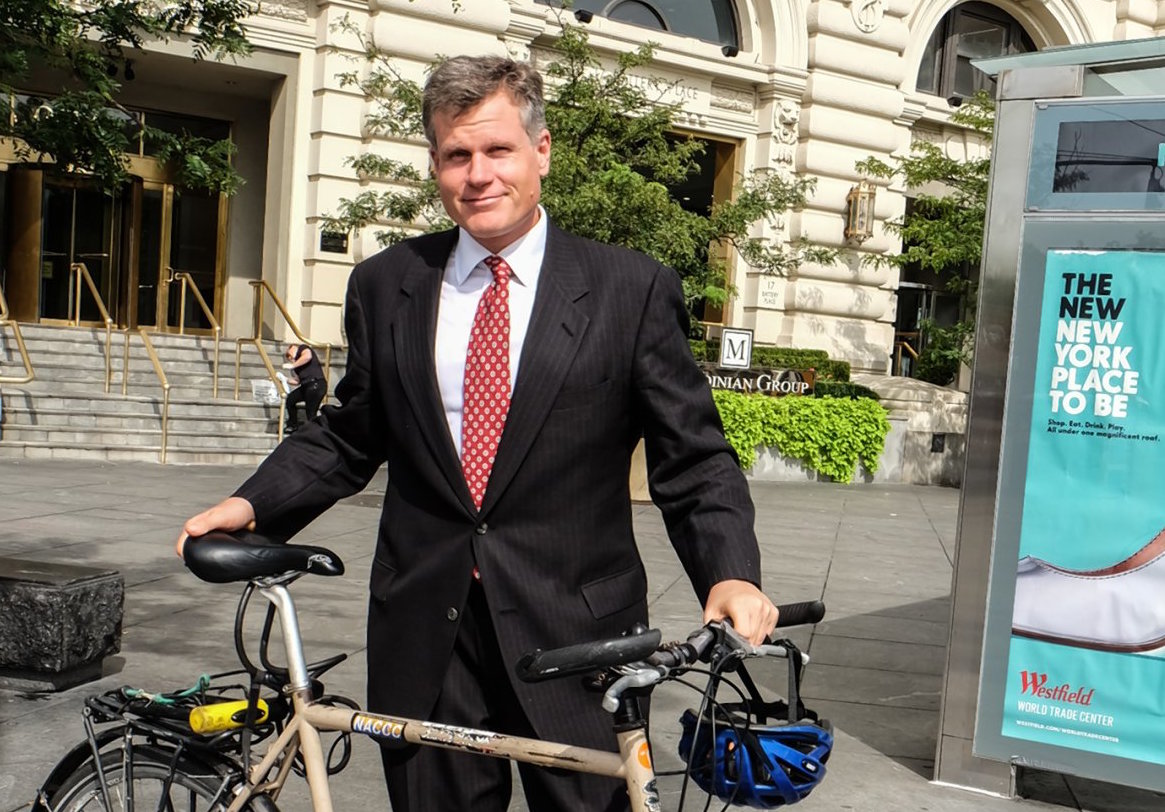
INTERVIEW BY LINCOLN ANDERSON | Steve Vaccaro has been described by the New York Law Journal as “perhaps New York City’s best-known lawyer advocate for bicyclist and pedestrian rights.” Since 2012, he has been a principal of Vaccaro & White, which specializes in legal advocacy for cyclists, pedestrians and other accident and crash victims. He grew up on Long Island and the Upper West Side, where he attended Calhoun High School. He received his B.A. from Wesleyan University and his law degree from Rutgers. Prior to entering the law, Vaccaro represented musicians and doctors in unions. He currently lives on the Upper East Side with his artist wife, Lisa Freedman, and they have two children. The Villager interviewed Vaccaro last month at his Battery Place office on one of the hottest and stickiest days of the end of the summer. The attorney was wearing blue shorts and a white T-shirt and in bare feet.
The Villager: Why are you in a T-shirt in shorts?
Steve Vaccaro: Because I was in court all day. I was saturated with sweat because the air conditioning in court wasn’t working. I was taking the subway. I just had to get out [of those clothes…]
VIL: What cases were you dealing with today?
S.V.: I had two cases. One was a case where a cyclist was doored by a cab driver who opened up his door into traffic at a taxi waiting stand on Union Square East at 16th St. The cab driver gave testimony, very similar to what cab drivers say, which is, number one, they never saw the cyclist first — but then they make all these statements about what the cyclist was doing wrong to cause the crash. In this case, he said the cyclist was too close to his door.
The cyclist testified she was proceeding between the cars parked at the curb on her right-hand side and the cars that were moving on her left, going uptown. She was going with the flow of traffic, proceeding in a straight line. She was where she was supposed to be.
The cab driver opens up the door, and he sends her to the ground. And she has multiple what are called comminuted fractures of her nose, meaning the bones are smashed up into little bits, and requiring surgery.
VIL: She went over the door?
S.V.: She hit the ground. She went sort of to the left. And luckily, she wasn’t run over. Doorings generally are not fatal, except in a second-strike scenario, which is really the worst nightmare — where you get doored and you get knocked into the path of a vehicle.
The cab driver’s saying she was too close, because he only opened his door by 4 inches. First he said it was 1 inch, and then he said 2 inches. I got him up to 4 inches. My argument is that there is no duty that a cyclist has to remain a certain amount of distance from a stationary object. And, in fact, there is a right to rely on the idea that that car is not going to have the door pop open unexpectedly. Because there’s an obligation on the part of the car occupants not to open the car door unless they can do so without interfering with traffic — including bicycle traffic.
A man holding a sheaf of papers walks buy outside the conference room’s glass wall, also wearing a T-shirt and shorts, but with sneakers and socks. Asked who it was, Vaccaro, whose back was to him, said it may have been his partner, Adam White, who has litigated even more bicycle personal-injury cases than he has.
VIL: Has your argument that cyclists don’t have to stay away from stationary objects been proven — is it precedent?
S.V.: The rule with respect to stationary objects is: Don’t hit them. And she didn’t. If she had been 4 inches over further into the traffic and then one of those cars hit her, they’d be saying, “She was in my way.”
The other case is a fellow who was riding his bike out in South Brooklyn. He was waiting at a red light, on a two-way street. And someone was making a left-turn off another street to go heading in the opposite direction from him on the same street he was on. And the driver just cuts into the lane. He was just standing there on his bike waiting. It smashes his leg, he has to have hardware put in, titanium rod to reset the bones.
VIL: How old are these victims?
S.V.: The fellow I’m describing now is in his late 50s. The woman in the first case is in her early 60s. She has been riding a bicycle in New York City her entire life. She’s a real New Yorker, an East Villager. She’s worked as a physical therapist, healing many crash victims, for at least 20 years. She’s just someone who gets around by bike.
The other guy, Jeff Heller, is an international human rights activist and lawyer who has won asylum for many victims. And he raises money for Human Rights First by going on extensive national bike trips, where he’ll ride out to the Midwest, to the Great Lakes, down to Texas, and people will pledge money for the organization.
The driver said she doesn’t remember hitting him, that the only way she knew there was a crash is that someone came up to her and told her.
VIL: She drove away from the accident?
S.V.: But stopped a little while after because people were telling her, “Stop, there’s a guy back there.” And she’s just saying, “I don’t remember anything,” which is what a lot of people who are actually the better ones, the better drivers say. You know, it’s still a lie to say, “I don’t remember anything.” But it’s a more benign sort of lie than making up some story that the cyclist jumped off their bike. A lot of times you hear from people, “The cyclist jumped off their bike, I didn’t come near them.” (Laughs.)
VIL: That they jumped off their bike to try to create an injury to themselves?
S.V.: Yeah, or just that bikers are crazy: “Who knows why they did it, but I had nothing to do with it.”
VIL: What kind of damages would you typically recover in a case like this?
S.V.: If you’re talking about a driver of limited means who goes to GEICO because they’re cheapest, chances are they have $25,000 worth of personal injury coverage. And so, you can smash someone’s leg, requiring metal hardware. You could take someone’s leg off. You could take both their legs off, and $25,000 would be the amount of the insurance. The person can go after your assets. But if you don’t really have any real property or significant assets, you’re probably just going to walk away, after changing that person’s life, with your insurance company paying the $25,000, and that’s it. And that is one of the things that is so shocking about driving in New York City, is that the amount of harm you can do is incalculable. But the amount of liability coverage or financial responsibility you’re required to really have in place is $25,000.
VIL: And what if the driver does have financial means and / or good coverage?
S.V.: Every case is different. But for people who have to have surgery and have metal hardware put in, or who lose parts of internal organs and things of that nature, the cases run into the hundreds of thousands or millions.
VIL: Is bicycling in New York worth the risk? Some would say not.
S.V.: I don’t think that you can ride a bike in the city your whole life without getting into some crashes, no matter how careful you are. You have to weigh it against what are your alternatives in terms of maintaining your fitness and maintaining your mental health? A lot of people wouldn’t give up cycling in the city, despite the dangers. Most injuries, thank God, are not all that serious.
VIL: I think, for cyclists, familiarity with your surroundings is important — and to go slow — to help avoid accidents.
S.V.: The thing I’d say about the bike infrastructure is that it calms the traffic, it makes it safer to bicycle, it creates a predictable space for each of the participants in traffic to be. And it’s a learning process.
Yes, you do need to be familiar with your surroundings. Look at First and Second Ave. separated bike paths as compared to Eighth and Ninth Ave. in Midtown. You have a much greater concentration of tourists and out-of-towners by Eighth and Ninth Ave., who are less familiar with the streets of New York and are less susceptible to that learning curve. So they all walk in the bike lane going to the Port Authority.
The irony is the cyclists fought to have those lanes put in on the rationale of “Hey, pedestrians, you don’t want bikes on the sidewalk, give us a space to be.” We got the protected bike path, and now it’s a sidewalk extension and there’s still no place for cyclists to be. But even now, it’s better than it was. And First and Second Ave. are really great.
VIL: What about the Jay St. bike lane in Downtown Brooklyn? It was recently moved from out in the street to in between the curb and the parked cars. Some non-cyclists are complaining about it. But before, cars were double-parking in the bike lane and forcing cyclists dangerously out into traffic.
S.V.: I think you don’t render your verdict until the bike lane has been in for a while and people have a chance to adjust. It has worked in other parts of the city that have comparable levels of foot traffic. You need to ticket motorists who park in the bike lane, because that’s a flagrant violation. There are “No Stopping” signs up, and that needs to be heavily enforced. They weren’t enforcing double-parking there before. They need to enforce blocking the bike path there, or you’re going to have chaos.
There will be issues with interactions, even with a protected bike path. But I think as long as cyclists bear in mind that you cannot go as fast in a protected bike path between the parked cars and the curb as you could in a vehicular traffic lane, you can still go at a reasonable rate of speed.
VIL: Apparently, Upper East Siders — including, notably, Woody Allen — really hate bike lanes. What exactly is their beef with bicycles?
S.V.: Yeah, and I’ve been to some of those meetings. (Chuckles.) I heard the most incredible story when I was at an Upper East Side community board meeting regarding which east-west cross streets they were going to install Class 2 bike lanes. Those are just paint, two white lines, where the bike lane is within the dooring zone of the parked cars. I would recommend that no one ever proceed faster than 10 miles an hour in one of those lanes because of the dooring hazard.
Anyway, there was a huge fight because no one wanted the lanes on their block: “Our block has hospitals.” “Our block has senior citizens.” “Our block has schools. There are kids — you’re going to bring bikes in?” Since when did it become gospel that kids and bikes don’t mix? Huh?

VIL: People are probably afraid that some renegade biker will be going too fast and hurt someone.
S.V.: But when, in fact, is the last time a renegade biker ever hurt a kid? When do you ever hear that? But I can tell you about so many kids who’ve been killed by renegade motorists. It happens all the time in New York City, and no says, “We’ve got to get these cars off our block.” The cars are the danger.
So this one parent gets up and says, “My kids go to school at Loyola on E. 84th St., and they have a play street and you can’t have a bike lane there. And I was watching the kids play the other day. I saw one little second grader running, and he ran right into a dumpster that was on the street and fell down. He was O.K., but he was crying. Now imagine the danger of having all these bicycles.”
Are we going to be living in padded rooms? I mean, don’t raise a kid in New York City if they’re not safe around stationary objects. That’s my advice to him. I mean that is ridiculous. (Laughs.)
VIL: O.K., how about the West Side?
S.V.: The West Side is interesting because the people are more politically sophisticated. I’m a West Sider, even though I live on the East Side. I grew up on W. 93rd St. You have many more cyclists on the West Side than you do on the Upper East. But you also have a lot of people who aren’t cyclists and have negative views, and they’re frankly much more formidable in their opposition to cyclists than the haters on the Upper East.
VIL: And why is that?
S.V.: They’re more politically savvy. They know how to make those arguments. You see it in the machinations of the community board. You don’t see them making the silly arguments of the type I just mentioned on the Upper East Side. (Laughs.)
VIL: So what kind of arguments do West Siders make?
S.V.: They read through the studies that D.O.T. [the city Department of Transportation] does and they come up with facially reasonable arguments about why the study wasn’t good enough, and they say, “We have to have another study, and please come back in two years.” And that’s what happened for about 20 years.
VIL: To delay.
S.V.: Yes. But eventually it couldn’t be prevented. So first, they fought the Columbus Ave. lane, and then the Columbus lane went in. And then they kept fighting, but still eventually the Amsterdam Ave. lane went in. So we have Columbus and Amsterdam, people are riding on them. The city has not ground to a halt. One thing you find in common anywhere you go, is people say, “There’ll be a traffic nightmare, ‘carmageddon.’ No one can move in traffic once you put in bike lanes.” And then they put the bike lanes in, and traffic continues to move. New York is still functioning.
VIL: What about the bridges? The Brooklyn Bridge is a nightmare for cyclists now because it’s jammed with tourists who want to put a “love lock” or “love earphones” on the bridge.
S.V.: There’s all these vying uses for public space in New York City that people are constantly thinking of — Pokemon Go.
VIL: What? That’s now a problem, too, Pokemon Go?
S.V.: It’s a competing public use. If you have people running around with their phone trying to position themselves in a certain way according to their video game, they could end up running in front of a car or a bike or anything else.
VIL: Is that happening?
S.V.: I’m sure it’s happened. But no one’s reported it to me. The point I’m making is that we can have adjustments and changes in our uses of public space, and the city will still work. And if there’s one principle that makes sense, it should be getting people to reduce their footprint. You can get people out of their goddam S.U.V. as a single-occupant vehicle. We should be promoting smaller footprints for people to move around because we have a scarce resource — it’s space.
Part of what people love about the city is the mobility and the vibrancy and the density, and the proximity to other people. And cars just make no sense. It’s no social interaction in a car. Drivers are cut off, they’re listening to their music, they’re talking on their phone…
VIL: Or texting. I read that more drivers now die due to texting than drunk driving. … What about Citi Bike? You’re a supporter, right?

S.V.: Absolutely. It’s expanding, and they just hit another record, 60,000 trips in one day. Citi Bike is now as well used as public transportation in many small cities. It is an undeniable critical supplement to the mass transit system.
VIL: They’re such safe bikes. They’re slow. Why do you think some people oppose them so vehemently?
S.V.: Many people don’t like it because they don’t expect it, and they feel like it’s limiting what they had traditionally seen as their freedom to move around in their accustomed comfortable spaces.
People don’t like change. And that’s what we’re working through, in trying to encourage modal shift from motor vehicle traffic to bicycle traffic to walking.
VIL: Do you bicycle commute from the Upper East Side every day?
S.V.: Absolutely. Every day, pretty much, weather permitting. I go down Fifth Ave.; during the daytime, I’m more comfortable on the grid. At night, I recognize that drivers can pay a little less attention. And it can also be a little harder for me to see defects in the road. So I take a longer route home, going up the Hudson River greenway and along the Riverside Park bike path.
I go across at 96th St. I worked very hard — my son and I, actually — to get a shared bike / pedestrian path in Central Park at 96th St. It’s one of two in the park where you can share the path with pedestrians going crosstown. You don’t have to ride in the transverse, which is very dangerous. It’s a pedestrian path, with signage and decals saying cyclists are allowed, and telling cyclists to be careful and respectful of pedestrians.
The community board was livid. They said, “There’s gonna be blood in the streets. You’re giving away our park to the bikers.” But there has not been one incident, or one pedestrian injured.
People don’t want to accept any of this. They just go on crying, “The sky is falling. … Citi Bike is coming, it’s going to lower our property values.” And there is evidence, based on empirical research in peer-review journals — by people in the real estate industry — that Citi Bike increases the per-square-foot rate of commercial space.
VIL: Commercial, but not residential?
S.V.: It’s been studied in the context of commercial. If a Citi Bike dock is in front of your business, you have people coming and going right in front of your store. They look right in your window. What shop owners are losing is their own little personal parking space for their car that they’ve had for 20 years, and now they can’t do that anymore. But they should let go of that and accept the fact that it’s actually bringing traffic to their business.
VIL: My fantasy has always been that there would be one avenue in Manhattan dedicated to bikes, or a bike viaduct above the streets.
S.V.: It needs to be more decentralized. I remember back before there were protected bike paths in Manhattan and they were just talking about bringing it to Ninth Ave. I said we need it on Eighth and Ninth, First and Second, and Fifth and Sixth Aves., and then that would be it for protected bike paths north-south in Manhattan, and the rest would be the painted bike lanes.
And that’s pretty much what we’ve got. I mean, I don’t know what’s going to happen with Fifth Ave. — it has a buffered bike lane south of Madison Square Park — but Sixth is being built out. Sixth Ave. is getting a protected bike lane. So, really, it’s coming to pass in about 10 years. And the city lives on.
VIL: Do you give former Mayor Bloomberg a lot of credit for all of the new bike lanes and Citi Bike?
S.V.: Sure, because he backed up his Transportation commissioner, Janette Sadik-Khan.
VIL: How do you think Mayor de Blasio is doing on further expanding bike lanes, and implementing his own Vision Zero street safety initiative?
S.V.: I think de Blasio has done a good job of continuing the successes of Mayor Bloomberg in terms of alternative transportation and public space.
VIL: What kind of bike do you ride for commuting?
S.V.: I have a steel-frame Surly Long Haul Trucker. It’s heavy but strong. I have a road bike for weekends, for going-up-to-Nyack kind of thing.
Vaccaro’s client Jeffrey Heller — the cyclist who was injured in Brooklyn — was calling on the phone. Vaccaro had to take the call, and the interview, which had run 40 minutes, ended. As usual, the bike attorney would cycle home later that evening.


































